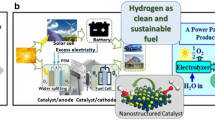Abstract
Reversible potentials (E R) have been measured for nickel hydroxide/oxyhydroxide couples over a range of KOH concentrations from 0·01–10 M. It is shown that the couples derived from the parentα- andβ-Ni(OH)2 systems can be distinguished by the relative change in KOH level on oxidation and reduction. In the case of couples derived from theα-class of materials a dependence of 0·470 moles of KOH per 2e change is found compared with 0·102 moles of KOH per 2e change for theβ-class of materials. Couples derived from theα- andβ-Ni(OH)2 systems can be encountered in a series of ‘activated’ and ‘de-activated’ forms having a range of formal potentialsE ′0 . ‘Activated’. and ‘de-activated’β-Ni(OH)2/β-NiOOH couples are found to lie in the range 0·443–0·470 V whilstα-Ni(OH)2/γ-NiOOH couples lie in the range 0·392–0·440 V w.r.t. Hg/HgO/KOH. It is demonstrated for ‘de-activated’,β-Ni(OH)2/β-NiOOH couples thatE R is independent of the degree of oxidation of the nickel cation between states of charge of 25% and 70%. SimilarlyE R is constant for states of charge between 12% and 60% for ‘activated’α-Ni(OH)2/γ-NiOOH couples. The constant potential regions are considered to be derived from heterogeneous equilibria between pairs of co-existing phases both containing nickel in upper and lower states of oxidation. Differences inE ′0 between the ‘activated’ and ‘de-activated’ couples are considered to be related to the degree of order/disorder in the crystal lattice.
Similar content being viewed by others
References
P. C. Milner and U. B. Thomas, in ‘Advances in Electrochemistry and Electrochemical Engineering’ Vol. 5, Interscience, New York (1967) p. 42.
J. P. Hoare, ‘The Electrochemistry of Oxygen’ Interscience, New York (1968).
S. U. Falk and A. J. Salkind, ‘Alkaline Storage Batteries’, Wiley and Sons, London, New York (1969) p. 48.
G. W. D. Briggs,Chem. Soc. Specialist Periodical Reports, Electrochemistry 4 (1974) 33.
D. J. Ives and G. J. Janz, ‘Reference Electrodes’, Academic Press, New York, London (1961) p. 331.
J. Zedner,Z. Elektrochem. 11 (1905) 809.
Idem, ibid 12 (1906) 463.
Idem, ibid 13 (1907) 752.
F. Foerster,Z. Elektrochem. 13 (1907) 414.
Idem, ibid 14 (1908) 285.
J. Besson,C.R. Acad. Sci. Paris 23 (1946) 28.
F. Kornfeil,Proc. 12th US Army Battery Research and Development Conference (1958) p. 22.
B. E. Conway and P. L. Bourgault,Canad. J. Chem. 37 (1959) 292.
Idem, ibid 38 (1960) 1557.
Idem, ibidB. E. Conway and P. L. Bourgault,Canad. J. Chem. 40 (1962) 1690.
B. E. Conway and P. L. Bourgault,Trans. Faraday. Soc. 58 (1962) 593.
B. E. Conway and E. Gileadi,Canad. J. Chem. 40 (1962) 1933.
H. Bode, K. Dehmelt and J. Witte,Electrochim. Acta 11 (1966) 1079.
H. Bode, K. Dehemelt and J. Witte,Z. Anorg. Allg. Chem. 1 (1969) 366.
E. A. Kaminskaya, N. Yu. Uflyand and S. A. Rozenteveig,Sbornik. Rab. Khim. Istochnikam Toka 4 (1969) 13.
N. Yu. Uflyand, A. M. Novakovskii and S. A. Osentsveig,Electrokhimiya 3 (1967) 537.
R. Barnard, G. T. Crickmore, J. A. Lee and F. L. Tye,J. Appl. Electrochem.
D. M. MacArthur,J. Electrochem. Soc. 117 (1970) 422.
P. Kelson, A. D. Sperrin and F. L. Tye, ‘Power Sources 4’, edited by D. H. Collins, Oriel Press (1973) p. 201.
E. Hausler, ‘Power Sources’ edited by D. H. Collins, Pergamon Press (1966) p. 287.
R. S. McEwen,J. Phys. Chem. 75 (1971) 1782.
G. W. D. Briggs and W. F. K. Wynne-Jones,Electrochim. Acta 7 (1962) 241.
A. B. Scott,J. Electrochem. Soc. 107 (1960) 941.
K. V. Kordesch, ‘Batteries’ Vol. 1 ‘Manganese Dioxide’ edited by K. V. Kordesch, Marcel Dekker, N.Y. (1974) p. 82, 84.
W. Fischer,Electrochim. Acta 21 (1976) 1001.
Idem, Paper presented atEuchem. Conference Le Hohwald (1977).
L. N. Sagoyan, Yu. M. Gulamov, P. Z. Barsukov and V. E. Dmitrenko,28th ISE Meeting, Bulgaria (1977) Extended Abstract no. 82.
D. Tuomi,J. Electrochem. Soc. 112 (1965) 1.
A. A. Yakovleva and Yu. N. Chernykh,Electrokhimiyia 6 (1970) 1671.
P. D. Lukovstev,Soviet Electrochem. 3 (1961) 156.
G. W. D. Briggs and M. Fleischmann,Trans. Faraday Soc. 67 (1971) 2397.
O. Glemser and J. Einerhand,Z. Anorg. Chem. 261 (1950) 26.
R. Barnard, C. F. Randell and F. L. Tye,J. Appl. Electrochem., to be published.
G. N. Lewis and M. Randall, ‘Thermodynamics’, McGraw-Hill Co, New York, London (1932) p. 327.
G. C. Akerlof and P. Bender,J. Amer. Chem. Soc. 70 (1948) 2366.
G. C. Akerlof and C. Kegeles,ibid 62 (1940) 620.
H. Bartl, H. Bode, G. Sterr and J. Witte,Electrochim. Acta 16 (1971) 615.
V. A. Volynskii and Yu. N. Chernykh,Electrokhimiya 13 (1977) 1874.
J. Labat,Ann Chim. 9 (1964) 399.
S. A. Aleshkevich, E. J. Golovchenko, V. P. Morozov and L. N. Sagoyan,Soviet Electrochem. 4 (1968) 530, 1117.
O. Rademacher, K. Wiesener and E. Prikryl,Z. Phys. Chem. 258 (1977) 113.
IUPAC ‘Selected Constants’, edited by G. Charlot, Butterworths, London (1971) p. 34.
R. Barnard, G. T. Crickmore, J. A. Lee and F. L. Tye, ‘Power Sources 6’, edited by D. H. Collins, Academic Press (1977) p. 161.
Author information
Authors and Affiliations
Rights and permissions
About this article
Cite this article
Barnard, R., Randell, C.F. & Tye, F.L. Studies concerning charged nickel hydroxide electrodes I. Measurement of reversible potentials. J Appl Electrochem 10, 109–125 (1980). https://doi.org/10.1007/BF00937345
Received:
Issue Date:
DOI: https://doi.org/10.1007/BF00937345




